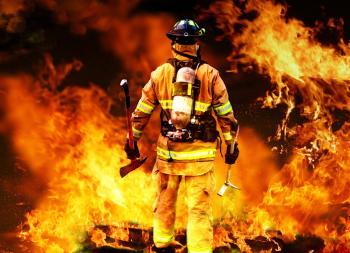Firefighting is recognized globally as one of the most dangerous professions. These men and women put their lives on the line each time they face a fire.
The most obvious danger of close proximity to flames is, of course, burns. There is, however, another more insidious killer that lurks behind the pyre.
In the United States, around 45 percent of firefighters’ on-duty deaths are due to cardiovascular events.
To investigate why this might be the case, a group of researchers studied 19 healthy, nonsmoking firefighters from Scotland in the United Kingdom. Their findings, released this week in the journal Circulation, are the first to demonstrate specific changes in the blood following involvement in a fire simulation test.
The participants took part in two fire simulation exercises, which were 1 week apart. During these events, they rescued a “victim,” weighing more than 170 pounds, from a two-storey structure while they were exposed to temperatures above 752°F (400°C).
The participants’ blood pressures were monitored for 30 minutes before the exercise and 24 hours after. Lead author Nicholas Mills, Ph.D., explains: “The firefighters wore heart monitors that continuously assessed their heart rate, heart rhythm, and the strength and timing of electrical impulses passing through each part of the heart. We analyzed these to look for evidence of heart strain that might signify a lack of blood being delivered to the heart muscle.”
Dr. Mills says: “These harsh conditions can cause injury to the heart muscle in healthy firefighters and may explain the link between fire suppression and risk of heart attacks.”
Blood clotting and firefighting
The researchers also investigated other factors by examining the firefighters’ blood. Blood samples were taken immediately after the exercise, and then at the 4- and 24-hour mark. From these samples, they assessed a number of parameters, including fibrinolysis and platelet activation, in order to assess how readily the blood clotted.
The team found that the risk of blood clotting increased in response to physical exertion and extreme temperatures. Although the exact pathways by which extreme heat can cause heart problems is not yet fully understood, this study gives new clues.
“Lower blood pressure immediately following fire suppression is likely due to dehydration and an increase in blood being diverted to the skin to help the body cool down.
We discovered the core body temperature increased, on average, nearly 2 degrees Fahrenheit over 20 minutes. And increases in hemoglobin occur as the body loses water and the blood gets more concentrated.”
Dr. Nicholas Mills, chair of cardiology and consultant cardiologist, University of Edinburgh, Scotland
Although the study focused specifically on firefighters and aimed to explain their susceptibility to cardiac problems, the findings have a wider relevance. Anyone that exerts themselves in extreme temperatures should take time afterward to rehydrate and cool down.
The study is accompanied by an editorial written by Dr. Stefanos N. Kales, associate professor at the Harvard Medical School and chief of occupational and environmental medicine at the Cambridge Health Alliance, part of the Harvard School of Public Health in Cambridge, MA.
Dr. Kales writes: “This new study should encourage practitioners to aggressively evaluate and treat firefighters for cardiovascular disease risk factors, and when indicated, perform additional studies – such as exercise stress testing, coronary artery calcium scans, or echocardiography – to detect atherosclerosis or cardiac enlargement.”
By maintaining a good level of fitness and engaging in active cooling and re-hydration following firefights, these men and women may be able to reverse any cardiovascular risks, at least in part. Raising awareness of these potential threats could save the lives of many lifesavers.
Source: http://bit.ly/2oxwYfL











